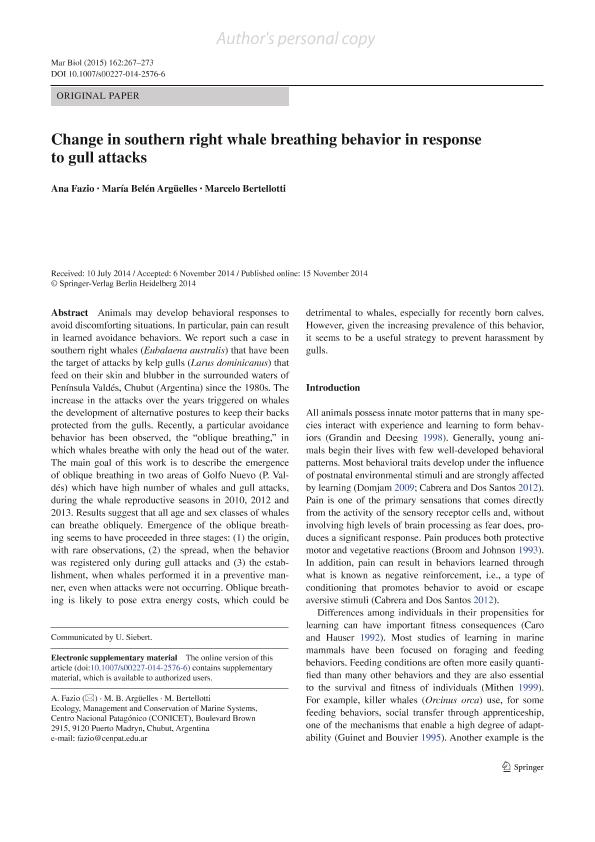Mostrar el registro sencillo del ítem
dc.contributor.author
Fazio, Ana

dc.contributor.author
Argüelles, María Belén

dc.contributor.author
Bertellotti, Nestor Marcelo

dc.date.available
2017-08-22T14:41:32Z
dc.date.issued
2014-11-15
dc.identifier.citation
Fazio, Ana; Argüelles, María Belén; Bertellotti, Nestor Marcelo; Change in southern right whale breathing behavior in response to gull attacks; Springer Verlag Berlín; Marine Biology; 162; 2; 15-11-2014; 267-273
dc.identifier.issn
0025-3162
dc.identifier.uri
http://hdl.handle.net/11336/22759
dc.description.abstract
Animals may develop behavioral responses to avoid discomforting situations. In particular, pain can result in learned avoidance behaviors. We report such a case in southern right whales (Eubalaena australis) that have been the target of attacks by kelp gulls (Larus dominicanus) that feed on their skin and blubber in the surrounded waters of Península Valdés, Chubut (Argentina) since the 1980s. The increase in the attacks over the years triggered on whales the development of alternative postures to keep their backs protected from the gulls. Recently, a particular avoidance behavior has been observed, the “oblique breathing,” in which whales breathe with only the head out of the water. The main goal of this work is to describe the emergence of oblique breathing in two areas of Golfo Nuevo (P. Valdés) which have high number of whales and gull attacks, during the whale reproductive seasons in 2010, 2012 and 2013. Results suggest that all age and sex classes of whales can breathe obliquely. Emergence of the oblique breathing seems to have proceeded in three stages: (1) the origin, with rare observations, (2) the spread, when the behavior was registered only during gull attacks and (3) the establishment, when whales performed it in a preventive manner, even when attacks were not occurring. Oblique breathing is likely to pose extra energy costs, which could be detrimental to whales, especially for recently born calves. However, given the increasing prevalence of this behavior, it seems to be a useful strategy to prevent harassment by gulls.
dc.format
application/pdf
dc.language.iso
eng
dc.publisher
Springer Verlag Berlín

dc.rights
info:eu-repo/semantics/openAccess
dc.rights.uri
https://creativecommons.org/licenses/by-nc-sa/2.5/ar/
dc.subject
Southern Right Whale
dc.subject
Kelp Gull
dc.subject
Parasitic Interaction
dc.subject
Attack
dc.subject.classification
Bioquímica y Biología Molecular

dc.subject.classification
Ciencias Biológicas

dc.subject.classification
CIENCIAS NATURALES Y EXACTAS

dc.title
Change in southern right whale breathing behavior in response to gull attacks
dc.type
info:eu-repo/semantics/article
dc.type
info:ar-repo/semantics/artículo
dc.type
info:eu-repo/semantics/publishedVersion
dc.date.updated
2017-07-27T12:33:32Z
dc.identifier.eissn
1432-1793
dc.journal.volume
162
dc.journal.number
2
dc.journal.pagination
267-273
dc.journal.pais
Alemania

dc.journal.ciudad
Berlin
dc.description.fil
Fil: Fazio, Ana. Consejo Nacional de Investigaciones Científicas y Técnicas. Centro Nacional Patagónico; Argentina
dc.description.fil
Fil: Argüelles, María Belén. Consejo Nacional de Investigaciones Científicas y Técnicas. Centro Nacional Patagónico; Argentina
dc.description.fil
Fil: Bertellotti, Nestor Marcelo. Consejo Nacional de Investigaciones Científicas y Técnicas. Centro Nacional Patagónico; Argentina
dc.journal.title
Marine Biology

dc.relation.alternativeid
info:eu-repo/semantics/altIdentifier/doi/http://dx.doi.org/10.1007/s00227-014-2576-6
dc.relation.alternativeid
info:eu-repo/semantics/altIdentifier/url/https://link.springer.com/article/10.1007%2Fs00227-014-2576-6
Archivos asociados
